-
Shopping Tools
-
Care & Maintenance
-
About
-
Dealer Login

Add distilled water—never tap—to protect plates from mineral buildup, preserve capacity, and extend service life. Check levels after charging and fill just above the plates.
If you maintain or own golf carts, proper battery watering is the simplest way to keep performance strong and replacement costs low. The chemistry inside flooded lead-acid batteries (the most common type in carts) relies on a clean electrolyte blend of sulfuric acid and pure water. Introducing minerals from tap water disrupts that balance, increasing internal resistance and accelerating wear. Below is a complete guide to the right water to use, when to add it, and how to avoid the pitfalls that shorten battery life.
Distilled water is produced by boiling and re-condensing water, which removes dissolved minerals and salts. That purity is crucial inside a battery:
By contrast, even “good” tap water contains enough dissolved solids to contaminate plates over time. The result is sluggish charging, voltage sag under load, and a steady drop in range.
Always check and adjust water levels after a full charge, not before. Charging expands and agitates the electrolyte; filling too early invites overflow and acid loss.
Pro tip: Log dates and notes (which cells needed topping, unusual odor, etc.). Patterns help you catch problems—like a thirsty cell or failing charger—before they get expensive.
Using tap water introduces contaminants that attach to plate surfaces and disrupt electron flow. Over repeated top-offs, this produces:
If tap water was used once by mistake, switch to distilled immediately. An equalization charge (only if your charger and manufacturer guidelines allow) may help, but severe contamination is usually irreversible.
Is deionized (DI) water acceptable?
Generally yes—DI is also mineral-free and commonly used when distilled isn’t available. Distilled remains the simplest, most universal recommendation.
Do AGM or lithium batteries need water?
No. Sealed AGM and lithium chemistries are maintenance-free and must not be watered. Watering applies only to flooded lead-acid batteries.
What tools make watering easier?
A squeeze bottle or funnel, flashlight, paper towels, a baking soda solution, and safety gear. Fleet users may add a watering system to standardize fills.
Electrolyte contains sulfuric acid. If a spill occurs, neutralize with a baking soda/water mix until fizzing stops, rinse with clean water, and dry. Dispose of towels safely. Avoid open flames and sparks around charging batteries, and ensure good ventilation.
Using distilled water at the correct time and level preserves electrolyte purity, keeps internal resistance low, and extends the life and range of your cart. Pair this simple routine with regular charging and clean connections, and your battery pack will deliver reliable power season after season—keeping your golf carts ready for every round.
